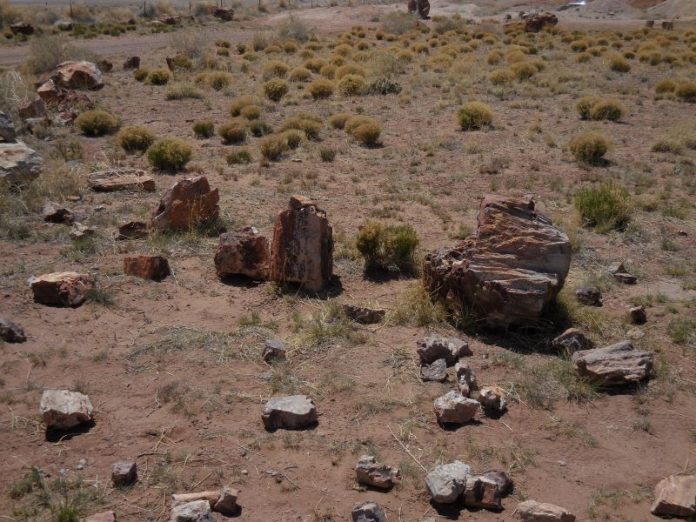
Petrified wood is a beautiful rock collector find. If you’re traveling near the Petrified Forest, the DoBell Ranch provides a fun and rockhound road trip collecting opportunity.
Long before the Petrified Forest became a National Park, the first of four men (and one young boy) named Francis Albert DoBell traveled from Albuquerque, New Mexico, to just outside of Holbrook, Arizona, to visit his uncle Bill, who owned 40 acres of agatized wood-rich land. He fell in love with the land immediately and a woman later. That was 1928. In 2023, that same land is still producing gorgeous rainbow wood and is loved and operated as a dig-it-yourself site by his descendants.
This is the history of the family who owns this land, adjacent to the southwest border of the Petrified Forest National Park. It’s about their venture to run a business open to rock clubs, businesses and individuals looking to dig or just pick up their own piece of the ancient petrified forest. It’s also the story of the National Park, its people and how this land became so rich in rainbow wood.
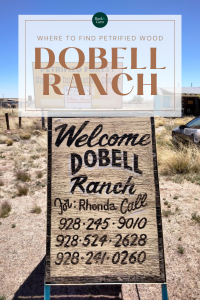
How it All Started
In 1928, Francis DoBell, Sr. (Frank) had just moved to Albuquerque from Cincinnati with his father when he decided to visit his uncle Bill at the property southeast of Holbrook, Arizona. He knew from the start that this place was special. A year later, in 1929, he purchased that land from his uncle.
At that time, Frank, Sr. was a machinist for the copper mines in Globe, Arizona, repairing the boxcars used to transport the ore from the mines. He made many trips back to the ranch where Uncle Bill still lived. The two men often attended the weekly dances held at the privately owned Stone House, now the National Park Service (NPS) Painted Desert Inn at the north end of Petrified Forest National Park. That is where both men met their future wives and this story begins.
At one of those dances in 1932, Frank met Edna May, who owned and operated the curio shop and small motel on the site of what is now the National Park Service’s Rainbow Forest Lodge Gift Shop near the south entrance of the National Park.
Some of the buildings still used today to house park rangers were part of this original motel complex. The original curio shop has been replaced by a new store and is now part of the Park’s Ortega Concessions.
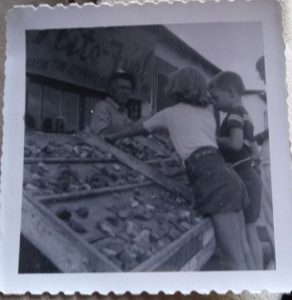
(DoBell family photo)
The Early Years
Frank, Sr. and Edna May married in 1934. As newlyweds, Frank continued to work for the mines in Globe, while Edna May ran the curio shop and motel until, like many other folks affected by the Depression, Frank was laid off from the mine. He returned to the ranch full-time; Edna May sold the curio shop and motel and the couple opened their own curio shop on their ranch property.
The old highway originally ran through the DoBell property and right past the couple’s store founded in 1936. Part of that store still stands today next to the cement brick home built by Frank, Sr. An original sign still hangs there, advertising petrified wood at five cents and up.
The Next Generations
Francis, Sr. and Edna May gave birth to Francis, Jr. During those years, they continued to collect and sell the agatized wood to park visitors.
As an adult, Frank, Jr. raised cattle on an adjacent property and also ran a well drilling operation while still helping his parents find and sell the petrified wood on their ranch. Frank, Jr.’s son, Frank III and his wife, Rhonda have since taken over the operation of the business with Rhonda handling most of the day-to-day operations. Early in their tenure, park boundaries changed and a new Highway 180 was constructed south of the ranch.
At that time, Frank and Rhonda constructed a new blue, 12’ x 12’ building to serve as the new curio shop. Today, the blue building still stands just off the new highway, but visitors are greeted with a billboard and sign with contact information to reach Rhonda and get directions to the dig site.
Frank III and Rhonda have three children, a son, Frank IV, two daughters and eight grandchildren including Frank V, age seven as of the writing of this article. All of their children and grandchildren participate in the business, especially their 16-year-old granddaughter, Ariel, who has been helping her grandma with customers and learning the ropes of the business each summer since she was eight.
The business is five generations strong with the potential to continue long into the future. Since 1973, however, most of the surface rainbow petrified wood has gone to new homes with visitors to the ranch. Not to worry, as there is plenty more beneath the surface. Recently several large trees, one over 35 feet long have been found.
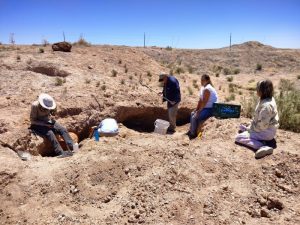
(DoBell family photo)
History of the Petrified Wood National Park
The land known as the Petrified Forest was declared a National Monument in 1906. In December of 1962, it was given National Park status and currently encompasses over 221,000 acres.
The park is made up of the Painted Desert in the north and the Petrified Forest in the south. It is the only National Park that contains a segment of the original Route 66 as well as a section of the National Old Trails highway.
One of the major features within the park is the Agate House, a structure built entirely of petrified wood, between 1050 and 1300 A.D. by the Puebloan people. The foundation of this eight-room structure was first excavated in the early 1930s and reconstructed by members of the Civilian Conservation Corps (CCC) between 1933-34, under the guidance of archeologist, Cornelius B. Cosgrove, Jr.
Since then, hundreds of additional foundations have been discovered within the park. It is believed that Agate House is just one of many homes that made up a large agricultural community once located here, including Puerco Pueblo.
Native Hopi Influence
Today, the Hopi Reservation lies northwest of this area. Hopi have the longest authenticated history of occupation of a single area of any Native American tribe in the U.S. And they may very well be descendants of the Anasazi and Puebloan. The name Hopi can be translated as “the peaceful ones.”
Native Hopi artist, Fred Kabotie, was commissioned in 1948 to provide the artwork in the remodeled Painted Desert Inn, the same place where Frank, Sr. and Edna May met at a dance in 1932.
An old photo from a DoBell album shows a horse-drawn wagon of people with a written caption “Going to the Snake Dances.” It’s not clear where in the area this Hopi ceremonial dance was performed.
The ‘Snake Dance” is an annual 16-day ceremonial event usually held in late August. Most of the ceremonies are held in private, however, on the last day, the public is often invited while Native Hopi wear traditional Kachina (doll-like) regalia and dance handling live snakes.
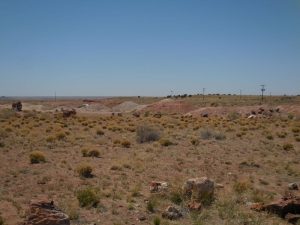
(DoBell family photo)
Area Geology
The National Park is part of the Chinle Formation. The Painted Desert found at the north entrance to the park is an ancient riverbed carved into the landscape over millions of years. The colors that ‘painted’ those formations were a result of varying water levels and the minerals, including hematite, limonite and gypsum, found at each high and low water level over time.
As you drive south within the park, the petrified forest of fossilized trees appears. These fallen trees lived in the late Triassic period about 225 million years ago and were washed downstream where they have now gathered. What makes these fossilized trees different from other petrified wood is their outstanding color.
During this period, these downed trees were buried by sediment containing volcanic ash. Groundwater dissolved silicon dioxide from the ash and deposited it into the logs forming quartz crystals. Over time, these deposits replaced the organic material in the trees. Traces of iron and other minerals combined with the silica to create the gorgeous colors found in the petrified wood in this area.
National Park Petrified Wood Collection Rules
It’s important to remember if you plan to visit the National Park, to retain a receipt for any petrified wood that you purchase or collect before entering the park. Rhonda recommends that you declare your purchases at the entry gate. She offers receipts to all visitors to their ranch.
Park rules DO NOT ALLOW collection of any minerals or artifacts within the park, and your car may be searched. Fines for collecting wood or artifacts within the park start at $325.
A legend of bad luck surrounding the illegal collection of wood has produced what Park Rangers call a “Conscience Pile.” Every year, the Park receives packages containing chunks of agatized wood, some with letters from folks who felt guilty about taking the wood, sometimes claiming that bad luck or illness followed them home with the rocks they collected within the Park. As rangers have no idea where those pieces were originally collected, they put them all in one place, the “Conscience Pile.”
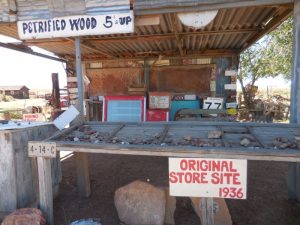
(DoBell family photo)
Dobell Ranch Today
Today, the DoBell ranch is open, by appointment, for Rock Club field trips, rock and mineral businesses buying in bulk, as well as individual rockhounds and families who want to purchase or dig their own agatized petrified wood.
If you find yourself in the area without prior arrangements, Rhonda says that you should still give her a call. Most days, someone is at the ranch, but she recommends, to avoid disappointment, call ahead.
On Saturdays from May to October, Rhonda hosts clubs for field trips. She calls October, “Rocktober” because it is her busiest month. This past May, she hosted two clubs on the same Saturday—nearly 80 rockhounds—she said it was “fun.”
Groups pay per five-gallon bucket collected, which includes a lunch of hamburgers, hotdogs, chips and Rhonda’s homemade chili beans. The ranch has hosted clubs from as far away as North Carolina.
Individual rockhounds and families can contact Rhonda by phone before a visit to arrange a time to either dig your own or just scour the ranch surface for the colorful “rainbow rock” already harvested. As of the writing of this article, the price for a 5-gallon bucket of agatized wood is $50.
If you are not able to travel to the ranch, Rhonda also takes orders by phone and ships the rainbow wood via a mail order service.
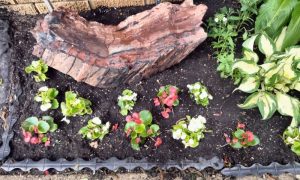
(DoBell family photo)
Petrified Wood Collecting: Directions & Information
The DoBell fee site is located about one mile northwest of the south entrance to Petrified Forest National Park on U.S. Highway 180. Check out DoBell Curios/Rhonda’s Petrified Wood Dig at DoBell Ranch on Facebook, Trip Advisor or call Rhonda at (928) 245 9010. Note: the lowercase ‘b’ on the Facebook page. (GPS: N 34 48 03 W 109 54 30)
Lodging and camping is available in nearby Holbrook, Arizona. In the National Park, there is no lodging and there are no RV campgrounds. Backcountry camping is available with a permit from either of the two visitors’ centers. Camping is also available on the DoBell ranch so be sure to ask when arranging your visit as no official campsites or services are provided.
You can expect to have a fun-filled day at the DoBell Ranch and take home some gorgeous Arizona Rainbow wood for your collection, jewelry project or to decorate your yard. Rhonda doesn’t consider visitors to the ranch customers, she calls everyone who visits “a friend.”
This story about DoBell Ranch previously appeared in Rock & Gem magazine. Click here to subscribe. Story and photos by Sue Eyre.













